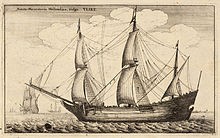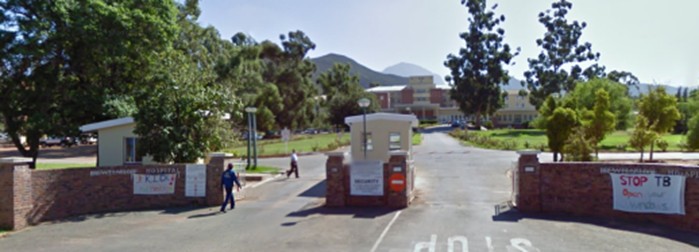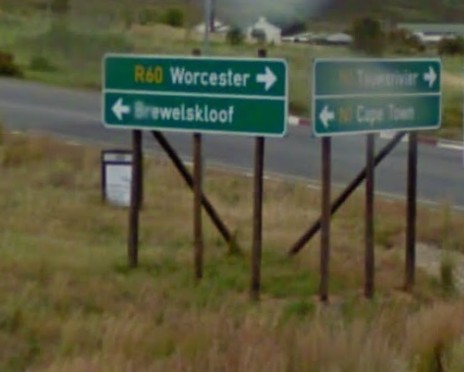• Charles Marais (abt 1640-1689) and Catherine Taboureux (abt 1642-1729)
• Claude Marais (1662-aft.1729)
• Charles Marais (1668-1711)
• Isaac Marais (1677-?)
• Maarie-Madeleine Marais (1682-1716)
• Philippe Foucher (abt 1657-1708) and Anne Souchay (abt 1659-after 1708)
• Anne Foucher (1681-1713)
• Esther Foucher (1683-1689)
• Jacques Foucher (1685-1689)
• Gaspard Foucher (1667-1688)
• Jacques Pinard (1665-1712) and Esther Foucher (1666-1697)
• Gédéon Malherbe (1663-1713)
• Estienne Bruère (1665-before 1750)
• Jean le Roux (1667-1711)
• Gabrièl le Roux (1669-1711)
• Pierre Sabatier (1665-?)
• Jean Machepaste (1662-1689)
• Paul Godefroy (1665-1699)
• Marguerite Basche (1665-1688)
1688

The Voorschoten belonged to the Chamber of Delft and the Captain was Frans Villierius. It was a flyboat (Fluyt) with 3 masts and a rounded hull, 130 Dutch feet long. It was capable of carrying 150 people. The ship had to seek refuge against a gale force wind and heavy seas and on 13 April 1688 arrived at Saldanha Bay. Governor Simon Van Der Stel sent the Jupiter to go and fetch the Huguenots and it arrived in Table Bay on 26 April 1688 with 192 people on board. Amongst them are 22 Huguenots and the bachelor Estienne Bruere. Estienne was a wagon builder.
He must have arrived with fear and excitement in his heart 6,000 miles from home. This was not a romantic arrival but a very difficult trip for a refugee. He had to accustom himself to a land and climate different to what he knew. The culture was Dutch. He had to practice his trade but as farmer had to till virgin soil that had never been cultivated. Unlikely that he had any previous farming experience as a 23 year old tradesman. Things were certainly not easy. Within two generations the French language ceased to exist as home language and in 1707 the French language was banned in official communications with the Dutch authorities.
Estienne became known as Steven which is the Dutch version of the name and the Bruere became known as Bruel and later Bruwel and ultimately Bruwer as we know it today. We pick up more about him in all the archives using the various spellings used at the time.
1690
Estienne Bruere (25) married Ester de Ruelles (16) in 1690. They had no children together. She was born on 6 Nov 1674, Guînes, , Nord-Pas-de-Calais. Estienne is mentioned in various documents after arriving in the Cape. He is next mentioned in these records in 1690 when he receives assistance from the Batavian Fund. The Batavian Fund was providing pecuniary assistance to the immigrants in the Cape Of Good Hope. Luckily for us they kept meticulous records. Various researchers we give credit to have studied these and some even makes this information available in electronic format. Using this information we get a glimpse into the life of Estienne Bruere, those around him and those that follow them later on. In 1690 he appears as "Estienne Bruere and his espoused Esther de Ruelle," a daughter of Daniel de Ruelle.
Die NGK Drakenstein was established in the year 1691 in what is known as Paarl today. This was the third oldest congregation of the Nederduitse Gereformeerde Kerk in Suid-Afrika. The current ldest church in use in the country was built on site in 1805. The initial Bruere family had a lot to do with this church as members. Pierre Simond was the first preacher from 1691 until 1702 and he came to Africa in 1688 with the Huguenots. A lot can be read about him. Pierre Simond was in Stellenbosch first, just like Estienne Bruere. They must have known each other well with only a few memebers in the congregation. The second preacher was Petrus van Aken, 1714 - 19 Desember 1724).
Estienne Bruere (28) a Wagon Builder by trade started the farm Rust-en-Werk in Dal Josaphat. (Wellington) This was allocated to him by the VOC in 1692.
1693
Susanna Du Puys (15) with her widowed mother arrives in the Cape from Amsterdam 1693
1694
The farm Rust-en-Werk in Dal Josaphat transported onto Estienne Bruere's name on 28 Aug 1694
Rust-en-Werk
1701
Ester de Ruelles (27) died about 1701
1702
Estienne Bruere (38) married Susanna Du Puys (24) on 19 Feb 1702.
1703
Susanna Bruere [b1] is born around 1703. in Drakenstein, present day Paarl. No records for her birth or christening is found but she is the Scheepers Family Matriach. She was also the first child of Estienne after his marriage to Susanna. In later documents of the VOC in 1720 where he requests a farm it is mentioned that he has 6 children and his youngest son was only born in 1722. (als zijnde beladen met een vrouw en ses kleijne kinderen)
Pierre Simond the preacher that came to the Cape and was the dominee at Drakenstein left the parish in 1702 and the new preacher Petrus van Aken only joined in 1714. She might therefore have been christened somewhere else like Cape Town or Stellenbosch and more than likely in Drakenstein itself but the travelling preacher might not have entered it in the registered or the register might have been removed by Pierre Simond and only returned later. The latter scenario is the popular believe as Pierre left under a cloud but was refused free passage by the VOC and was in the Cape for a few years until making it to Europe under his own steam. This would explain the absence of any record for her.
1708
Estienne Bruere (44) buys the farm "Kykuit" from Fiscal Jan Blesius. *According the FW De Klerks Family Tree.
1709
Martha (Maria) Bruere [b2] is born in 1709. Martha (Maria) Bruere is christened on 11 Aug 1709 in NGK Stellenbosch. The Drakenstein parish were they stayed did have a preacher at the time.
In the Inventories Of The Orphan Chamber – Cape Town Archives Repository [MOOC10/1] on 29 November 1709 it is clear that Estienne is active and getting established in his new home. The sheriff was sent to collect some money from him for items he bought for 43 Ryksdalers and 6 Stuiwers from the estate of Lambert Smit. .
Steven Bruerre
Rd:s
1 waterpot en een houte stoel etc:a 1:3
2 rakjes 1:5
1 vat met een balij 5:1
50 stuks schapen 35:5
Somma Rd:s43:6
1711
Johanna Magdalena (Anna) Bruere [b3] is born in 1711. Johanna Magdalena (Anna) Bruere is christened on 8 Nov 1711 in NGK Drakenstein.
1712
In the Inventories Of The Orphan Chamber – Cape Town Archives Repository [MOOC10/1.72] on 10 February 1712 Steven Bruel must get 60 Ryksdaler from the estate of Lodewijk Pretorius that died .
Estienne Bruere (48) is granted the farm De Veerkeyker in the Land Van Waveren, south of Slangenhoek (Worcester/Robertson). Brewelskloof and Brewelskloof-Hosiptal is named after the family. (Bruere became Brewel and Bruwel) 12 Jan 1712

Brewelkloof Hospital

1714
Steven Bruere [b4] is born in 1714. Steven Bruere is christened on 7 Oct 1714 in NGK Drakenstein. The new preacher Petrus Van Aken was now at Drakenstein church.
1716
Anna Du Puys sensured by the Church Council of Drakenstein for her relationship with her slave in 1716 according to Spoelstra’s research. She was sensured because “eenseer boos leeven et haren slaaf lijden”. She had to sell the slave to be allowed back into the church, but refused. Later she claimed her husband refuses. He was then summonsed as a result he claimed the slave was already sold, but the Church Council demanded proof before allowing her back into the church. A lot has been written by various authors about her conduct at the time. In the context of slaves, the harsh conditions and the times she lived in it gives one a different perspective of the incident. The issue for the church was more than likely that the slave like most slaves at the time in the Cape from the Islam faith or a heathen. Slaves that practiced Christianity were not christened or baptized either as that would require them to be set free. Relationships across race barriers and between slaves and their owner happen often especially in Cape Town itself. In the rural area like Drakenstein this was however frowned upon and why the church consistory banned her from using communion. Interesting is that Steven Bruere the oldest son was born 2 years before this. He had no children of his own. The youngest son Johannes was born in 1722, six years after the unknown slave was sold. All the Bruwer’s are descendants of Johannes the youngest son.
1717
Esther (Hester) Bruere [b5] is born in 1717. Esther (Hester) Bruere is christened on 12 Sep 1717 in NGK Drakenstein
1718

In the Inventories Of The Orphan Chamber – Cape Town Archives Repository [MOOC8/3.94] on 14 April 1718 Steven Bruel buys on auction for 1 ½ Ryksdaler from the estate of Beeletje Frederikszs that died “2 Coornvorken, 1graef, 1 pik”. Also at this auction is David Senecal that buys some household items.
1719
In the Resolutions Of the Council Of Policy Of Cape Of Good Hope – Cape Town Archives Repository on Tuesday 21 November 1719 it is clear Estienne is still working of the debt he has.
“Estienne Bruere is in wesen, woond over de Bergh Rivier omtrent de Wagemakers Vallije, en in staad om jaarlijx iets af te doen ƒ357:10: “
1720
Elizabeth Bruere [b6] is born in 1720. Elizabeth Bruere is christened on 18 Aug 1720 in NGK Drakenstein
1722
In the Resolutions Of the Council Of Policy Of Cape Of Good Hope – Cape Town Archives Repository on Tuesday 12 January 1722 Estienne request the land of 61 morgen he is occupying as a loan property to become his own property. It is clear from the text that he is an honest hardworking citizen with a wife and six children. His youngest son was not born as yet.
“Geeft met behoorlijk respect te kennen Uwe Wel Edele Gestr. en E. Agtb. ootmoedigen dienaar, Steven bruere, landbouwer aan Drakensteijn, hoe denselven al ruijm neegen jaaren in leening heeft beseten seeker stuk lands gelegen onder het district van Drakensteijn, waar op hij al enige nodige gebouwen, soo van hokken als cralen, heeft getimmert, welk land ook met permissie van Uwe Wel Edele Gestre. is gemeeten en groot behouden 61 morgen en 400 quadraat roeden, gelijk 't geannexeerde caartje kan aanthoonen, soo neemt den supplt. de vrijheijd Uwe Wel Edele Gestr. en E. Agtb. zeer ootmoedig te versoeken dat gem. stuk land aan hem (als zijnde beladen met een vrouw en ses kleijne kinderen) in eijgendom mogte werden gegeven. Soo is goedgevonden denselven 't versogte land ter groote van 61 morgen en 400 quadraat roeden bij deesen in eijgendom te verlenen, ter consideratie 't selve al neegen jaaren precario beseten heeft, en dien persoon seer naarstig en van een eerlijk leven is”
Estienne (Steven) Bruere (57) obtains permission to the farm "De Hoop" 61 morgen in Robertson district on 27 Mar 1722 for his oldest son Steven (12) which became a Bruwer farm for generations .
Johannes Bruere [b7] is born in 1722. Johannes Bruere is christened on 6 Dec 1722 Cape Town. Johannes is a very important figure for the Bruwer’s as all the Bruwer’s are descendants of him.
1726
Susanna Bruere [b1] (23) married Gerrit Scheepers 9 Jun 1726 - Drakenstein
1728
Estienne Bruere (63) sells the farm De Veerkeyker on 25 Nov 1728 to Philippe Mesnard [Menaer] (b5) for the Minaar family.
1730
Estienne Bruere (65) starts farming on “leeningplaats de Zandrivier geleegen aan de Rietfontijn” more commonly known as Willemnelsrivier. This farm still form part of the Bruwer family farming activities. In 1820 Jacobus Stephanus Bruwer took control of most of the farm after he bought the farms from two of his brothers and their families who joined Piet Retief's Trek to Port Natal. Jacobus Stephanus was a prosperous farmer and is the ancestor of most of the Bruwers still farming in the Robertson area. He was also on the board of directors who founded the town of Robertson in 1853.
1732
Maria Bruere [b2] (23) married David Senecal 30 Nov 1732 - Stellenbosch
1750
Estienne Bruere died before or during 1750 as his daughter in her Last Will and Testament on 5 November 1750 refers to him as deceased.
1760
MOOC8/10.71a, Hermanus Keeve is owed on 28 Augustus 1760 van Susanna du Plessies wed:e Bruel over boekschuld 39:20. Proof that Estienne has died already and that Susanna Du Puy was now using the name at the time of “Susana du Plessies”